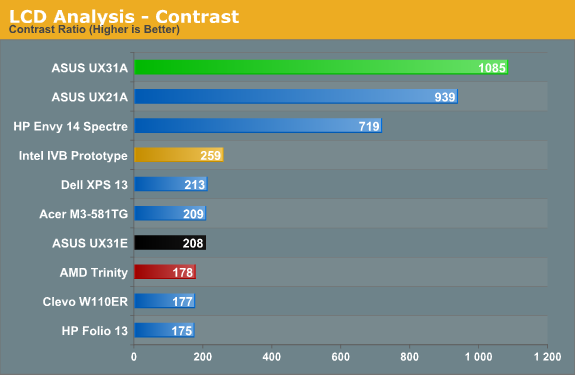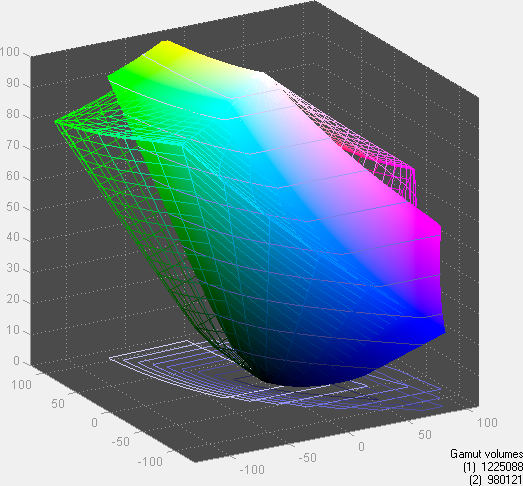ASUS UX31A: Putting the Ultra in Ultrabooks
by Jarred Walton on August 28, 2012 9:00 AM EST- Posted in
- Laptops
- Intel
- Asus
- Ivy Bridge
- Zenbook Prime
- Ultrabook
ASUS UX31A: First Screens First
Normally we save our look at the LCD characteristics for last, but in this case the LCD happens to be one of the highlights of the product. No one else is doing 1080p IPS screens in a 13.3” laptop that I know of (though obviously with the screens available for ASUS we may see some uptake from other manufacturers in the near future), so the UX31A is in a class by itself. We’ve commented on the overall good build quality and keyboard, but it’s the display that really sells the UX31A. Here’s how it stacks up to other Ultrabooks.






Desktop LCDs might still be better for the most part, but contrast ratios above 1000:1 in laptops—with matte displays—are practically unheard of. ASUS tops our contrast ratio chart, but it doesn’t end there. At 400 nits maximum brightness, it’s also one of the brightest LCDs you can find (though not with perfect colors, and post-calibration you’re looking at 300-350 nits, depending on how you calibrate). Obviously battery life will suffer if you run at 100% brightness, but there are occasions (e.g. outside in the sunlight) where it will be necessary and it’s great to have that option. In practice, I was able to use the UX31A—thanks to the matte surface—in a car without trouble with the LCD set to around 200 nits, and I was extremely pleased to not have to look at my reflection for a change (not that I’m ugly, mind, but vanity can only take you so far…).
As for color quality and accuracy, ASUS gives up a bit of ground there compared to some other higher quality LCDs, but dE of less than 2.0 after calibration is good in the laptop world and the color gamut is a respectable 80%. That gamut actually isn’t quite right, though—the gamut is wider than AdobeRGB in some areas but less in others, so if you’re working within the AdobeRGB color space it’s more like 67%. If you’re serious enough about color accuracy that you have the necessary hardware and software for calibrating your laptop, you may not be completely satisfied with the UX31A’s display, but you’ll really have to spend a lot of money to find a better laptop LCD (e.g. the $500+ LCD upgrades found on high-end mobile workstations).
Viewing angles is obviously where IPS can really shine, and while there’s a loss in brightness and contrast at acute angles, there’s no color shifting to worry about. Use it at a desk, on your lap, in an airplane, or wherever else you might find yourself and the UX31A display will still be completely usable. In 2012, this is what we’d like to see from all laptops, but in particular there’s no excuse for $1000+ laptops and notebooks to continue peddling sub-standard TN panels. ASUS gets a well-deserved gold star for their choice of display.
With all the good we have to say about the LCD, we do need to offer one minor word of caution. Windows 7 still doesn’t handle DPI scaling perfectly, and 1080p in 13.3” makes this one of the highest density LCDs around. Windows 8 may improve on the situation, but for those who stick with Windows 7 you’ll still encounter the occasional quirk. ASUS ships with the DPI scaling set to 125% as mentioned earlier, and it’s really necessary if you want most text to be legible. Even with the minor issues with some applications, though, I’d take this sort of display ten times out of ten if given the option.


 Front_thumb.jpg)
 Right_thumb.jpg)
 Left_thumb.jpg)
 Top Minor_thumb.jpg)
 Top Major_thumb.jpg)
 Bottom Minor_thumb.jpg)
_575px.jpg)








106 Comments
View All Comments
Aikouka - Tuesday, August 28, 2012 - link
I got the Elantech drivers ( Version V10.5.10.0 ) that I'm using from ASUS's website:http://support.asus.com/Download.aspx?SLanguage=en...
They're only about a month old, which isn't too bad. Finding that link can be a pain though... I had to go back to the forums where someone posted it ( http://forums.anandtech.com/showpost.php?p=3372897... ) just to find it!
JarredWalton - Tuesday, August 28, 2012 - link
Interesting... I actually was probably at that page before but didn't notice the "Elantech" option about three down. That said: WTF REQUIRES 146MB!? A touchpad driver should be about 1/10 that at most. :-\Aikouka - Tuesday, August 28, 2012 - link
Haha! That was my reaction when I saw the download size as well! I get the feeling that it's some monstrous package that is capable of servicing a lot of different products... kind of like graphics drivers?Although, I don't know how many products Elantech has.
JarredWalton - Tuesday, August 28, 2012 - link
Okay, so I've downloaded the actual Elantec drivers from ASUS' site now to see if they're any better. One thing they do have that the ASUS drivers lack is a "Smart detector" option that you can customize to help avoid accidental activation of the touchpad while you're typing. The default setting is too small for my liking, but if you set it to use a "large" area you can get it so that it mostly rejects input while you type. I'm not sure how good it is because this is the first I've tried it, but the above paragraph was typed with me basically resting my thumb near the palm on the touchpad and I didn't get any activations where my text got screwed up. I'm going to go update that page of the article just for completeness' sake, though I still feel like it's not quite at the same level as a good Synaptics touchpad.amrs - Tuesday, August 28, 2012 - link
Samsung's Ivy Bridge Ultrabook needs some more quality reviews, like Anandtech's... Is this planned?Personally I think the RAM issue is something of a concern. Hopefully someone puts out a model with 8 GB.
Toshio - Tuesday, August 28, 2012 - link
+1 on a review in this one, many sites consider it the best thin+light windows notebook.RetroEvolute - Tuesday, August 28, 2012 - link
I actually would have bought this ultrabook, but when I saw that it used a proprietary connector for its SSD, and soldered the RAM in (and at only 4GB), I really can't justify it. Everything else about it seems so great.On goes the wait for the perfect ultrabook.
Beenthere - Tuesday, August 28, 2012 - link
There is a good reason why Ultrabooks don't sell even with lots of Intel bribe money.The reality is that there is nothing Ultra about these toys other than the high price. Most folks can see that there are many better, cheaper options for 99% of the world. If you're one of those who must own an Ultrabook, jump in. Otherwise your money is better spent elsewhere.
roc1 - Tuesday, August 28, 2012 - link
Jarred, could you tell me if the audio jack can also be used as a line-in? It is important for me to record sound from my synthesizer on the go.Thanks! Great review :)
JarredWalton - Tuesday, August 28, 2012 - link
As far as I can tell, and going by the specs as well, it only works for speakers/headphones -- no mic or line-in support. So if you need that and you don't want a USB adapter, you'll need to look elsewhere.